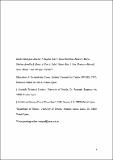Por favor, use este identificador para citar o enlazar a este item:
http://hdl.handle.net/10261/206734COMPARTIR / EXPORTAR:
 SHARE SHARE
 CORE
BASE CORE
BASE
|
|
| Visualizar otros formatos: MARC | Dublin Core | RDF | ORE | MODS | METS | DIDL | DATACITE | |

| Título: | Sustainable Thermochemical Single-Step Process to Obtain Magnetic Activated Carbons from Chestnut Industrial Wastes |
Autor: | Rodríguez-Sánchez, Sandra ; Ruiz Bobes, Begoña CSIC ORCID; Martínez-Blanco, David; Sánchez-Arenillas, M. CSIC ORCID; Díez Díaz-Estébanez, María Antonia CSIC ORCID ; Suárez Ruiz, Isabel CSIC ; Marco, J.F. CSIC ORCID CVN ; Blanco, J.; Fuente Alonso, Enrique CSIC ORCID | Palabras clave: | Biomass Chestnut industrial waste Food industry Magnetic activated carbon (MAC) Sustainable activation One-step chemical activation Vibrating sample magnetometer (VSM) |
Fecha de publicación: | 24-sep-2019 | Editor: | American Chemical Society | Citación: | ACS Sustainable Chemistry and Engineering 7: 17293-17305 (2019) | Resumen: | A novel thermochemical process based on a single step was optimized to obtain magnetic activated carbons from an industrial biomass waste. Anhydrous iron chloride was used as an activating agent and mixed directly with the chestnut shell waste. The effect of the activation temperature (220-800 °C) on the chemical, morphological, textural, and magnetic properties of the materials was studied. The results demonstrated the presence of different iron compounds depending on the activation temperature set as well as their influence on morphological and textural development of the magnetic activated carbons (BET specific surface area, S up to 568 m g, total pore volume, V, up to 0.294 cm g vs 1 m g and 0.007 cm g, respectively, for the raw biomass waste). The techniques employed, especially Mössbauer spectroscopy, showed relative contributions of the different iron compounds (magnetite, maghemite, metallic iron, and so on) in the materials. The higher activation temperature (800 °C) favored the formation of metal Fe and iron carbide. Additionally, the magnetic properties measured by vibrating sample magnetometry confirmed the coexistence of different ferromagnetic phases with the remanent magnetization, M, (up to 3.88 emu/g) and coercivity, H, (up to 140 Oe), being larger as the activation temperature increases. A higher activation temperature favored the development and evolution toward other iron compounds, while at low temperature, 220 °C, the presence of these compounds were null, and their behavior resembled the results obtained for the original biomass waste. | Versión del editor: | http://dx.doi.org/10.1021/acssuschemeng.9b04141 | URI: | http://hdl.handle.net/10261/206734 | DOI: | 10.1021/acssuschemeng.9b04141 | Identificadores: | doi: 10.1021/acssuschemeng.9b04141 issn: 2168-0485 |
| Aparece en las colecciones: | (IQF) Artículos (INCAR) Artículos |
Ficheros en este ítem:
| Fichero | Descripción | Tamaño | Formato | |
|---|---|---|---|---|
| Sustainable_thermochemical_Rodriguez.pdf | 3,01 MB | Adobe PDF |  Visualizar/Abrir |
CORE Recommender
SCOPUSTM
Citations
19
checked on 17-abr-2024
WEB OF SCIENCETM
Citations
19
checked on 25-feb-2024
Page view(s)
199
checked on 24-abr-2024
Download(s)
237
checked on 24-abr-2024
Google ScholarTM
Check
Altmetric
Altmetric
NOTA: Los ítems de Digital.CSIC están protegidos por copyright, con todos los derechos reservados, a menos que se indique lo contrario.
